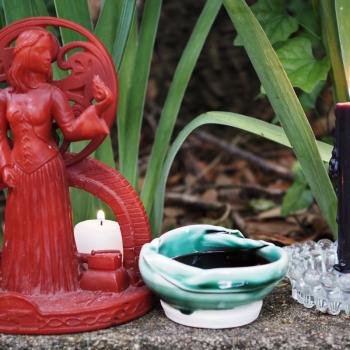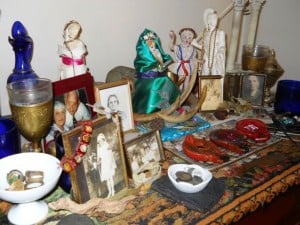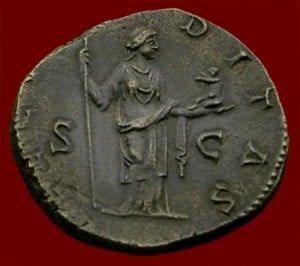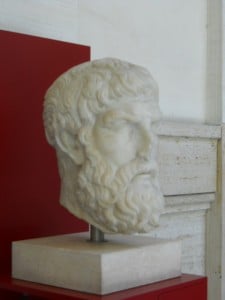Grant, O Gods, that the earth may lie soft and gently upon the shades of our ancestors, and may their urns be filled with a perpetual springtime blooming with the sweet scents of crocus.

The second day of Lemuria is held five days before the Ides of May. As with other Roman festivals, the Lemuria is held on alternating days because odd-numbered days were considered fortunate. Perusius, quoted above (Satura 7.207-208), again expresses a Roman conception of the afterlife in an eternal Spring. This was not just a conceived notion, since the Romans acted upon it by holding picnics with their deceased relatives outside the City at their family tombs. They celebrated with the dead, rather than mourned them. They prepared food and drink to share with the deceased. Some Roman tombs have been found with shafts and pipes through which to pour libations and pass found to their loved ones. They also made items of pottery, as in the example at left, that represented food offered to the dead and buried at the tombs along with flasks of wine and cooking utensils. They would decorate the tombs in a festive manner, and when the day was coming to an end they would leave lamps filled with olive oil to burn throughout the night. And along the way home they would stop to leave grain, milk, honey, salt and oil for the Lemures on pottery shards at crossroads .
Last month I mentioned how in my family we celebrate funerals in a festive manner, with food and drink, music, humorous stories and jokes. Quite the contrast from how I have seen others mourn whose backgrounds are in different traditions. Perhaps this has to do with a belief we hold that evil influences, as might hover around the dead, can be dispelled by laughter. Mirth is thus a way to not only honor the memories we have of our deceased family members, but also a way to protect them as they start their journey into the afterlife. To me, therefore, it makes perfect sense that in a Spring month like May we hold feasts for the dead, as picnics out in the countryside, to enjoy the fresh air and flowers with our family members, both living and dead.

At the National Museum of Archaeology and History in Constasa, Romania, there is a display of a Roman burial of an old woman. At her feet is a large cooking pot along with some oil lamps. The ceramic vials and implements on her legs are cosmetics, where the small glass vial at her knees probably contained medications. She was probably hard of hearing, as the ear horn next to her medicines indicates. The larger glass bottles carried drinks for her to enjoy. Her wrists, torso and head are adorned with gold jewelry that served as much as amulets as they did decoration. At the same museum I was surprised to see how much gold was worn as amulets to protect young children. A child of about seven was adorned with no less than 130 gold coins, busts, and winged Lares, as well as a gold necklace, a gold bracelet, and his bulla. He was heavily weighted down. Maybe that was the idea; keep him safe by preventing him from running off to far. It was believed that children were vulnerable to evil beings that might prey on them. The same was true of the newly deceased, because they were thought to be reborn into a new life after death. The anniversary of a person’s death was celebrated as his birthday (dies natalis), rather than the day he had previously been born into life.
So what did Romans believe awaited them in the afterlife?
Mother Earth, indeed to You I pray, settle lightly on these bones, as she knew that piety is the reward of she who merits it, and whoever sincerely stands out in performing her own pious duties may be carried on that happy path to the Gods above. (CIL 6, 9204)

Pietas is the Roman virtue of dutifulness towards your family and your ancestors. Attending to the rites owed to your Lares, it was expected that your descendants would care for your rites after you had died. That is what the funerary inscription above infers. Beyond that there was the hope that one would be regarded as worthy to live with the Gods. Notions varied on what that may mean. Arriving at the Blessed Isles, one might be allowed to live as a cupid in the Garden of Venus. At right, a funerary stela depicts the Lady Faustina as Venus with Her attribute of a dove. Her intention is to participate in Venus. Others though had their deceased relatives as being carried by winged figures in scenes of apotheosis where the hope was to become a demigod or hero living among the stars on the celestial Via Sacra. Cicero’s Dream of Scipio describes such an afterlife for the few who are judged to be heroes, and Ovid speaks of the same idea in the Metamorphoses. Virgil instead poses that people are reincarnated into a new life, where the time one spends in the Underworld, and the type of life one is reborn into, depend upon how one had lived in this life. Varro, on the other hand thought that all souls are reincarnated every 440 years. Actually the literary elite expressed a number of ideas, based in philosophy, and only extremely rare do such notions appear on Roman funerary inscriptions. Tens of thousands of inscriptions call upon their ancestors to accept the deceased among themselves, as Lares, rather than allow their loved ones to roam aimlessly in between life and death as a Lemur.
The most frequent formula found on Roman funerary inscriptions is “D. M.” This stands for “To the Divine Manes” (Dis Manibus) to indicate a sacrifice is offered to them. On of the most interesting inscriptions I have come upon is that of a woman praying to the Manes for her husband.
Whole-heartedly I pray to you, most holy Manes, may you admit my dear husband among you, and, may you want to be most indulging in this, that in the hours of the night I may see him and also be advised by him on what to do, in order that I may be able to swiftly and sweetly come stand by his side. (CIL 6, 18817)
This woman fully expected to continue being advised by the spirit of her deceased husband, whether in visions or dreams at night. That is, if the Manes accepted him as one of the honored Lares. It is also telling, too, that she prays that she might also be allowed to join with her husband and with their family after her own death. In that way she may be honored as one of the family’s Lares and she would thereby forever be surrounded by her family, her grandchildren and her great grandchildren’s grandchildren on those days of Spring when all the generations gather for a picnic. The more you learn about our religious tradition you shall find how central is the family in every aspect of our traditions and practices. When we speak of the Gods it is natural for us to include our Lares in our thoughts as among the Gods. Whenever we hold festivals and ritual meals, it is our deceased family members whom we invite to attend our celebrations. Hearth and home are our temples, a place for our Lares to reside, just as the Roman statesman Marcus Cicero once told the pontiffs, “What is more sacred than each citizen’s home? It houses his altars, his hearths, his Penates, his sacrifices; it is the place of his devotions and ritual ceremonies.” This is what inspires the cultores Deorum Romanorum today. Not the ruins of ancient temples on the hillsides of Rome, but what is found in the company of our family and our Gods and Goddesses.















